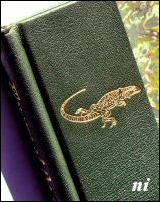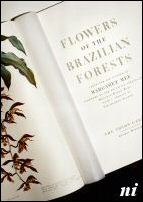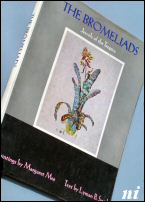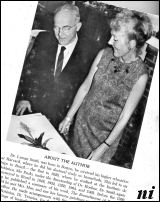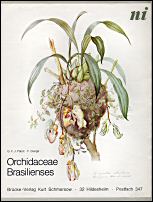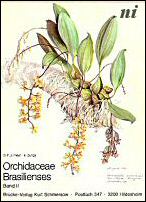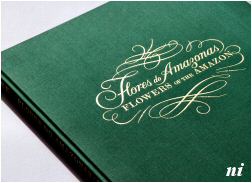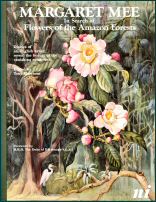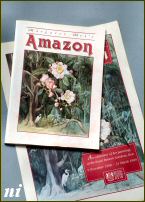| |
| | 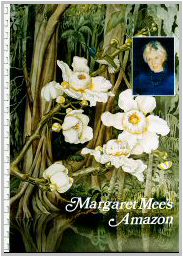 | MARGARET
MEE'S AMAZON | | A
THEME CREATED BY TONY MORRISON | ©
1987 | | | | Margaret
Mee's Books | | Her
life embraced art, politics, the threatened environment and a quest for a very
elusive Amazon flower. Most of all all Margaret was an brilliant story-teller
. |
| The
Birth of a Legend |
|
| Margaret
Mee began painting flowers in Brasil in the 1950's. This is an account of her
principal and highly valued works leading to the launch of Margaret Mee's Amazon
a major exhibition in London when sixty of her paintings were published in
a catalogue in November 1988 All
books, catalogues and other publications produced after Margaret's death in 1988
are not included. | |
| |
Beginnings
After a challenging political life in London fortytwo year old Margaret arrived
in Brasil in November 1951 and almost immediately found a job teaching art at
St Paul's, the British school in São Paulo. St Paul's was at the heart
of a patriotic British Community with numerous connections to the Brasilian elite.
While teaching at St.Paul's she made her first journey to the Amazon forest and
in 1958 twenty five of her paintings were exhibited in the São Paulo house
of the Cultura Inglesa an organisation devoted to the arts and cultural
exchange between Britain and Brasil. The Exhibition opened on Monday May 5th and
soon afterwards she was offered work as a botanical illustrator at the Instituto
de Botânica de São Paulo. | 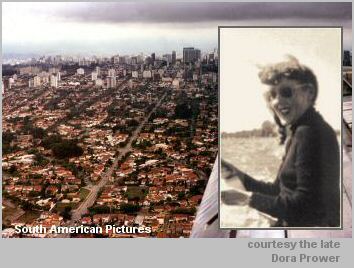 |
| Margaret
lived in a southern suburb of the rapidly growing city |
| Margaret
found herself working on the Bromeliaceae, a group of plants that with
one exception is unique to the Americas. The Bromeliad Family has a variety of
forms from the straggly grey Spanish moss found on trees and even telephone wires
to the those with brilliant colours in the rainforests. Margaret's
work was commissioned to illustrate the Flora Brasilica an extraordinarily
ambitious documentary project to catalogue and illustrate the plants of Brasil.
The Flora Brasilica was the brainchild of Carlos Federico Hoehne and it got off
to a good start. Several volumes were published and can still be found in specialist
stores. But by the late 1950's the costs were mounting. Mad
about Plants Federico Carlos Hoehne was born in 1899 in the small town of
Juiz da Fora, set in wooded country in the State of Minas Gerais some 180kms from
Rio de Janeiro. In those days Rio was the capital of Brasil. Hoehne had a passion
for plants and his career began when he was appointed the chief gardener at the
Museu Nacional in Rio de Janeiro. He travelled in Brasil on plant collecting
expeditions and was a botanist on the Roosevelt-Rondon Expedition to Amazonia
in 1913-14. Theodore Roosevelt an ex- president of the USA took a privately funded
expedition to the western Amazon and the Brasilian Government appointed Candido
Rondon,a sertanista - someone who had immense experience of the interior
of the country - to be the interpreter. Afterwards Carlos Hoehne continued in
the Brasilian botanical world and helped found the Instituto
de Botânica de São Paulo. Travels
and travaux The Instituto de Botânica arranged for Margaret to
join collecting expeditions in the Brasilian coastal mountains near São
Paulo and further away to the forested slopes of Serra dos Órgãos
50kms north of Rio de Janeiro. In 1960 she travelled to the dry scrublands of
Pernambuco and Ceara some 2000kms northwest. Margaret worked with Brasilian specialists
and later from 1964 with an American botanist, Lyman B Smith, who had been granted
use of the facilties at the Institute. Lyman Smith with a doctorate from Harvard
[USA] made his first visit to Brasil in 1928 and was a world expert on the subject
of the Bromeliad Family. He knew that Margaret's paintings of bromeliads for the
Flora Brasilica may never be published due to shortage of funds and instead were
to be kept locked in the archives. Margaret was aware of this too and often considered
leaving her job as she had personal plans for a book and needed paintings she
owned. Lyman Smith had his own ideas and arranged with Dr.Alcides Teixeira the
director of the Institute at that time to buy a set of twenty paintings for the
Smithsonian Institution, Washington. Dr Teixeira lent a further thirty for as
long as they were needed by Lyman Smith. |
| Carlos
Hoehne: 1882-1959 - Lyman B Smith: 1904-1997 and Margaret Mee 1909-1988 .
To this day much of Margaret's work for the Institute remains in its archives
in São Paulo as part of a unique record of Brasilian flora. A collection
of over sixty of these paintings was published in Brasil by the Instituto de Botânica
de São Paulo and the BANESPA bank in 1992 |
|
FLOWERS
OF THE BRAZILIAN FORESTS 1967 |
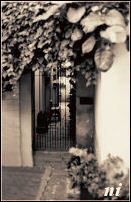
Courtesy
David Lorimer | |
|
|
| In
1965 Margaret moved to a house in Rua Fiandeiras, Vila Olympica at that time a
suburb close to
São Paulo's
Congonhas airport | Luxury
binding of morocco and marbled paper sides: Courtesy The late Sally Duchess of
Westminster. Detail of the gold embossing and the frontispiece Catasetum saccatum
an orchid from the Mato Grosso | |
| This
magnificent folio
is the greatest work produced for Margaret and had a long history involving both
her talents and some lucky timing. When she was working as an artist at the Instituto
de Botânica de São Paulo Margaret often wondered how she could
create a book but she could have had no idea of how beautiful it would be. In
1960 an exhibition of her work was shown at the Halls of the Royal Horticulural
Society in London and she was awarded the Society's Grenfell Medal. Then in the
following year influential friends in Brasil suggested she should seek help from
the very top of British society. Margaret's work had caught the attention of Sir
George Taylor who at that time was the Director of the Royal Botanic Gardens,
Kew. Sir George had been Director of the Royal Botanic Gardens, Kew since 1956
and was knighted in 1962. He was also a member of the Council of the Royal Horticultural
Society. Another cog in the wheel was The Hon.Aylmer Tryon the son of the Ist
Baron Tryon and just two months younger than Margaret. He had just opened a gallery
for 'natural history art' in Dover Street, London. The very exclusive Tryon Gallery
lay in the heart of Mayfair, an outrageously expensive part of the capital and
was
already establishing a reputation for exhibiting and selling the finest collections.
Wilfrid Blunt an art critic who made his name for botanical art with a book The
Art of Botanical Illustration [William Collins 1950] was also approached.
Over the next two or three years a plan took shape and HRH Prince Philip, Duke
of Edinburgh agreed to be a Patron. Aylmer Tryon arranged with George Rainbird
a gifted designer and publisher to create the folio. Rainbird was the only state
educated member of the team and had founded his own publishing company in 1951.
The work was to be of the highest quality and expensive. There
was no looking back and along the way to success another exhibition gave extra
impetus. In 1964 the Museu de Arte in São Paulo presented a collection
of Margaret's work titled Flora Brasilica and this helped to establish
her reputation with numerous botanists and artists in Brasil and London. One reviewer
later commented that the 'exhibition and the folio book Flowers of the Brazilian
Forests will go down in the history of botany' Production.
Margaret left the Instituto de Botânica in 1965 and devoted much
of her her time to the book. It contains 31 plates and a Frontispiece making a
total of 32 works from various sources. Each plate is described scientifically
by a one of 10 specialists including Lyman Smith and Guido Pabst. In most pages
a small black and white sketch separates their notes from an extract from Margaret's
diaries. Two pages of maps with plant locations were included; Acknowledgements
were given by Aylmer Tryon, Sir George Taylor wrote the Preface and Roberto Burle
Marx contributed a glowing Introduction. The book was 'Produced under the Patronage
of H.RH.THE DUKE OF EDINBURGH,K.G' In
the mid 1950's George Rainbird had acquired Zaehnsdorf specialists in exquisite
binding. The firm was established in London in 1842 by Joseph Zaehnsdorf from
Budapest and it rose to become one of Europe's most famous binders using traditional
leatherwork. Rainbird also needed the finest printing for the plates and printing
he chose L.Van Leer and Company, Amsterdam [Ed note: Viewed today in the world
of computer based scanning the plates made in 1967 appear to lack detail and some
fine gradation. But in the 1960's they were wonderful examples of printing craft.
They convey character and depth often lacking in modern computer based printing]
The work was drawn together during the summer of 1967 and Margaret had to work
from dawn to dusk producing one hundred individual paintings for the '100 luxury
copies' The binding was finished with real gold leaf and the tops of the pages
were gilded.
| November
1967 A
'Private View' at the Tryon Gallery was followed by a dinner in her honour to
launch Flowers of the Brazilian Forests. The Press announced the book with
enormous acclaim largely because it was a publishing landmark in a 'Beatles' era
Britain still recovering from post Second World War austerity. Most of the 500
copies were sold in advance. The Times {London} said 'almost sold out at 175
guineas a copy'. In those years that sum was about three months salary for
a junior schoolteacher. But perhaps the most fascinating of all the reviews appeared
in the Journal of The Royal Horticultural Society when Wilfred Blunt wrote of
her paintings: "They place Mrs Mee in the first rank of botanical artists.
Indeed they would stand without shame in the high company of Georg Dionys Ehret
and Redoute." .. Blunt was naming two of
the greatest botanical painters of all time. Wilfrid Blunt was the brother of
Sir Anthony Blunt, Surveyor of the Queen's Paintings, a curiously archaic title
and whose life behind the facade told another story. Anthony Blunt was a master
spy and passed information to the USSR [the Soviet Union]. By the time of the
launch his allegiance to Communism was known to the British Intelligence Services
and in 1979 he was 'outed' and stripped of his title. [the knighthood / and address
'Sir' was taken away]. Wilfrid was not without blemishes either and he had upset
the botanical world with his comments about the paintings of the wealthy Victorian
traveller Marianne North whose work is still housed in a special gallery at the
Royal Botanic Gardens, Kew. [The Art of Botanical Illustration, 1950].
Dates, names and backgrounds will appear in Time Line] The
November launch was followed by 'An Exhibition of Water-colours by Margaret Mee
including the majority of the originals for 'Flowers of the Brazilian Forests'.
4th -17th January 1968 The Tryon Galllery 41/42 Dover Street London W1.'
The folio carries the copyright date 1968 | 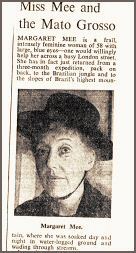 |
| | Flowers
of the Brazilian Forests
-
Published by The Tryon Gallery in association with George Rainbird 1968. The plates
were made by L.Van Leer and Company N.V of Amsterdam. The binding was by Zaehnsdorf
of London. Copies A-F were not sold and were reserved for Margaret and her friends.
Copies 1- 100 were bound in full vellum and each contained a small original drawing.
Copies 101- 500 were quarter bound in morocco with hand marbled paper sides made
by the Societé des Papieres Keller Dorian et Tutois Frères réunis.
A few very basic file copies
were made with
blue cloth binding and inscribed -'ex-series'. All editions were presented in
slip cases |
|
THE
BROMELIADS JEWELS
OF THE TROPICS 1969 | |
The
book contains 32 plates printed on lightly glazed paper. Each painting is
approximately 175mm high x 124mm wide placed centrally on a single page. Paintings
numbered 1 - 11 and 13 to 16 are from works held in the Smithsonian Institution,
Washington [USA], 17 to 20 and 31 and 32 are from the Instituto de Botânica
de São Paulo. Painting 10 is Vreesia erythrodactylon a species found
in the forests of the Serra do Mar along the Atlantic coast. This specimen
came from Caraguatatuba near Santos the port for São Paulo and the painting
was a gift from Margaret to Lyman Smith's wife. Meticulous notes for the species
accompany the plates |
|
|
The
jacket with a painting of Aechmea fosteriana lent by the Instituto de
Botânica de São Paulo and drawn from a plant growing in the country
garden of Brasil's internationally acclaimed artist and landscape designer the
late Roberto Burle Marx, Rio de Janeiro. The plant came from the area of Espirito
Santo to the north of Rio.
Lyman Smith with Margaret on the back of the book jacket |
| Lyman
Bradford Smith was born in Boston, Massachusetts, USA in 1904. He gained all
his academic qualifications at Harvard [USA] including a doctorate in 1930. He
focused his botanical interest on the Bromeliad family and made six trips to Brasil
before 1969. His first journey was in 1928 when he used a Sheldon Traveling Fellowship
to work in the Instituto de Botânica de São Paulo under the
direction of Carlos Hoehne. He worked largely on the bromeliads of the forests
of Santa Catarina some 430 kms southwest of Sâo Paulo. After World War II
he returned to Brasil in 1948, 1952. 1956 and again in 1964 when he met Margaret
who was still working for the Institute. A fine exhibition of Margaret's paintings
was staged at the Museum of Modern art In São Paulo in 1964 with the title
Flora Brasilica and attracted many VIPs. Her friendship with Lyman
Smith continued and she visited Washington in April 1967.
When Lyman Smith died
thirty years later he was remembered with great respect as the Father of the Bromeliads. |
| The
Bromeliads
-
with a jacket subtitle of 'Jewels of The Tropics', published by A.S.Barnes and
Co Inc Cranbury New Jersey 08512 with
Thomas Yoseloff Ltd, London Library
of Congress Catalogue Card Number: 68-27221 Text by Lyman B. Smith Paintings by
Margaret Mee | |
ORCHIDACEAE
BRASILIENSES
1975 + 1977 | |
|
|
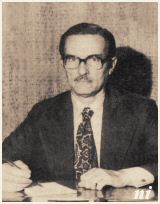
Guido
Pabst , courtesy Varig Brasilian Airlines | Guido
Joao Frederico Pabst was born in 1914 in Porto Alegre. Today it is a city of almost
two milliion, a river port and the capital of the Brasilian State of Rio Grande
do Sul. It is also the birthplace of Varig the leading Brasilian airline founded
on 7th May 1927 as S.A. Empresa de Viação Aérea Rio Grandense.
Pabst moved to Rio de Janeiro to become a executive director of the company and
devote his private life to studying orchids. He died in Rio de Janeiro in 1980. |
| Covers
of the two volumes [1] Coryanthes albertinae from the Rio Marauiá
, Amazonas and [2]Rudolfiella aurantiaca , Rio Cuieiras, Amazonas |
| Pabst's output
was phenomenal. He worked at the Varig offices near Santos Dumont airport
from 8 in the morning to 6 at night and he spent the evenings studying in the
Herbarium Bradeanum a private institution dedicated to botanical research, especially
everything concerning the Brasilian flora. Pabst wrote about orchids and by the
time he died he had published over 150 scientific papers, contributions and notes.
His work began in the 1950's and focused largely on habitats in the southeastern
states of Brasil where Santa Catarina and Rio Grande do Sul have rich forests.
He met Margaret through her involvement with the Jardim Botânico
{Botanical Garden] in Rio de Janeiro and was able to help her with her own work
with orchids and travel along Varig routes. A
major work. The culmination of his dedication to orchids is found seen in
the two volumes of Orchidaceae Brasilienses he created in collaboration
with Dr F. Dungs a fellow enthusiast. Their objective was to to present with illustrations
a record all the known orchid species in Brasil. The main illustrations were contributed
by Margaret Mee and another artist Samuel. Salvado. a remarkable Brasilian plant
illustrator. Each volume is complete with a full bibliography and the text is
in Portuguese, German and English.. |
| Orchidaceae
Brasilienses -published
by Brucke - Verlag Kurt Schmersow - 32 Hildesheim - Postfach 347, Germany Text
by G.F.J Pabst and F. Dungs . Illustrated with watercolours by Margaret Mee and
S.Salvado. Pen and ink drawings by G.F.J Pabst and A.C.Brade. ISBN 3871050106
Dewey 584/.15/0981/ LCCN QK 495.064 P28 |
|
FLORES
DO AMAZONAS - FLOWERS OF THE AMAZON 1980 |
| A
large volume it measures 65.5 by 48.5 cms. Without slip case it weighs approximately
6.25 kilos. The design overall was by Greville Mee. John Warren provided three
designs. The introduction was written by Richard Evans Schultes, Harvard University
[USA] The preface was by Roberto Burle Marx and the botanical texts were written
by Guido Pabst assisted by botanists from The Smithsonian Institution, Washington
DC [USA], the Royal Botanical Gardens, Kew [England] the New York Botanical Garden,
[USA]. The translation of the text was by Guttorm Hansen and both Portuguese and
English versions appear side by side throughout. The
book contains twenty four plates each the full size of the book and a large [half
page] map of Amazonas with a key to where the plants were found.. All the plates
are bled to the edge of each page and some were printed separately for sale as
botanical prints. The paper is 200gsm wood free cartridge without an obvious watermark.
The plates in the book are interleaved with transluscent paper and each faces
a brief botanical and diary description. |
|
| The
gilt embossed cover and spine in English and Portuguese |
| Life
in Rio This enormous volume grew from Margaret's life in Rio de Janeiro. She
had moved there from São Paulo with Greville Mee in August 1968 and had
many friends in the tightly knit artistic and botanical society. In 1975 she was
granted the Freedom of Rio de Janeiro [Honoraria Carioca] and she was awarded
a small contract with EMBRATUR the Brasilian State Tourist Office to paint flowers
of the Atlantic rainforest. Also in 1975 a new Director had taken charge at EMBRATUR.
Fiftyfive year old Saïd Farhat was from Rio Branco, capital of the State
of Acre, in far western Amazonia. Farhat had wide experience in public relations
and advertising. He had worked in London in 1959 with a leading advertising company
and later with J Walter Thompson in Brasil. In 1976 Saïd Farhat created an
idea for a book of Margaret's paintings. It was to be a large, impressively presented
collection for distribution throughout the world to have a place in Brasil's diplomatic
and trade offices; it was to be given to visiting VIPs and in every way to be
a credit to Brasil and the Amazon. Margaret agreed and the plan moved ahead in
1977. The book drew together many people: botanists, artists and the staff of
EMBRATUR. Publication was set for 1979 though it was delayed slightly by local
circumstances. Honoured
In November 1979 Margaret was honoured with the Cruzeiro do Sul [Brasil's
highest award for foreigners]and the book was published in the following year.
An exhibition of thirty paintings, some from Flowers of the Amazon was held at
the Natural History Museum, South Kensington, London from October 1st to November
3rd 1980 to mark the launch in London. Margaret attended the opening and was welcomed
by H.E The Brasilian Ambassador, Sr.Roberto Campos and his wife. |
| Flores
do Amazonas - Flowers of the Amazon. Publisher: Distribuidora Record
de Servicios da Imprensa S.A. Rio de Janeiro, Brasil, Colour separations by Rommerts'
en van Santen /Van Leer b.v. 7 colour printing by Drukkerij de Lange/Van Leer
b.v [The Netherlands]. Supported by EMBRATUR [Empresa Brasileira de Turismo] 1000
numbered copies were distributed. Binding : green cloth with gold embossed title
on cover and spine. Each volume was presented in a slip case covered with green
cloth. | |
IN
SEARCH OF FLOWERS OF THE AMAZON FORESTS 1988 |
| 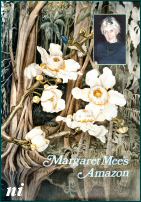
Margaret
Mee's Amazon 1987 |
The
book began life as a project for television created in 1987 by Tony Morrison.
It was given the working title Margaret Mee's Amazon and a folder explained
the idea. The folder had a limited production and was distributed to producers
and publishers. The title quickly became generic for exhibitions and publications.
This project stemmed from Tony's many years of travel in South America and a meeting
in Rio de Janeiro in 1970. The
original book of 1988 contains more original material than books with the generic
title published after 1989.
| |
| The
folder for Margaret Mee's Amazon was created with her help in 1987. The
painting is Gustavia pulchra [1977] and the photo is courtesy Sally Oliver | The
jacket of In Search of Flowers of the Amazon Forests, edited by Tony Morrison:
Forward by HRH The Duke of Edinburgh,. K.G.K.T. The painting is Gustavia augusta
1977 | | Preparation
Margaret Mee's Amazon was based on 'diaries' sometimes anecdotdal and sometimes
very factually written by Margaret during her travels in Amazonia. Now kept at
the Royal Botanic Gardens, Kew, [England] the diaries convey a vivid impression
but in 1987 when Tony Morrison first saw them he decided they needed editing.
He concuded that some order or structure was required before they could be read
or made into a film by anyone without a knowledge of the region or botany. Also
any television film would demand a strong thread and ending. The Nonesuch
Expeditions website offers several pages where the full story is revealed.
Margaret had reduced her handwritten diaries to fourteen untitled chapters in
typescript and had offered them to various well-known publishers. But she had
no acceptance for the story. The
Edit Rio de Janeiro 9.30 AM Friday January 16th 1988. The work began at Margaret
Mee's house in Santa Teresa and continued with long daily sessions until Sunday
28th February. Tony Morrison discussed each line with Margaret and recorded her
comments on magnetic tape. Back in England the notes were added to the extracts
Margaret Mee had drawn from her 'diaries', while relatives and friends were asked
for reminiscences about her early life. But more importantly this was the time
when the detailed planning was made for a search for the night flowering cactus
Selenicereus wittii destined to be the core of the final chapter,
Journey 15, The Moonflower Summer
in England 1988
- Production. - PCs [Personal Computers] were relatively new and expensive
and many word processing programmes were still in their simplest versions. Margaret's
'diary' excerpts were transferred to an IBM PC AT fitted with a 20MB hard drive.
Copies were kept on 5.5 inch 'floppy discs' and although slow by modern standards
it was simple to add the notes taken at the editing sessions either on a PC in
Rio de Janeiro or another in England. The rest of the story is history and will
appear in the Margaret Mee Archive.
The television film project was put to one side while the book was edited. Steps
were taken to create a Margaret Mee Amazon Trust with a Secretariat under the
care of Dr.Simon Mayo a research botanist at the Royal Botanic Gardens, Kew. Preparations
were made for the book launch in London and a short tour for Margaret Mee to cities
in the eastern USA. An exhibition of Margaret Mee's Amazon was planned
for the Autumn at the Royal Botanic Gardens, Kew. [London] The
launch - Tony Morrison arranged with Dr.John Hemming C.M.G, then Director
and Secretary of the Royal Geographical Society, and a longtime friend, for Margaret
Mee to address the Society in London. The event was packed and became the official
launch for the book. A similar address was arranged with the prestigious Anglo
Brasilian Society [London] together with appearances on British television and
the radio. At the same time Tony was in touch with Dr.Tom Lovejoy at the Smithsonian
Institution in Washington and Flo Stone of Earthwatch with a view to promoting
the cause of Amazonian survival. Margaret and her book would carry the message. The
USA tour -. Margaret left London for Philadelphia on 15th November for a series
of presentations including one at the Garden Club of America in Philadelphia,
another at The Smithsonian Institution, Washington, an address for BRASUS an NGO
[ONG]and a lunch at the New York Botanical Garden. At the end of the tour she
was welcomed on the New York PBS Television current affairs programme,The MacNeil
Lehrer News Hour, and interviewed by Robert MacNeil. The programme was seen across
America. She returned to London on November 23rd '..quite
simply one of the great nature books of the century....' The Sunday Times, London,
[England] This
book exists in five printings and only the first with the identification "First
published 1988" was printed before her death. The rear flap of the dust jacket
has a photograph of Margaret Mee "Along the Amazon 1988" and
a description of her life including the words "she lives in Rio de Janeiro,
Brazil". In later printings the text on the dust jacket refers to her death.
Also the black and white pencil sketches in the first printing are somewhat 'harsher
contrast' than in later printings. The printers chose to change the process to
introduce a better gradation from black to white in later printings. Only some
of the first printing were signed by Margaret Mee. An unknown number of private
gift copies may carry her signature. Others were signed at the launch events and
for Hatchards Bookshop, Piccadilly, London [England] ipso facto none of
the later printings carry her signature. This
is the only book of the Amazon Collection of paintings in their original state
- some of the paper has age or damp marks or is even fly-spotted. This was their
condition in mid -1988 before they were cleaned and restored at the Royal Botanic
Gardens, Kew, England | |
In
Search of Flowers of the Amazon Forests - Diaries of an English Artist - reveal
the beauty of the vanishing rainforests.
Based on the diaries of Margaret Mee Edited by Tony Morrison. Forward by HRH The
Duke of Edinburgh KG., KT. Published by Nonesuch Expeditions Ltd, England November
1988. Printed by Antique Collectors Club, Woodbridge Suffolk, Colour separations
by Chroma Graphics Singapore. ISBN 1 868901 08 8 The
fifth printing (1989) and the Brasilian Portuguese edition of the same year were
printed by Cowells Ltd, Ipswich, Suffolk and erroneously the publishing data was
not changed |
MARGARET
MEE'S AMAZON 1988 - a catalogue | | The
Amazon Collection At the founding meeting of the Margaret Mee Amazon Trust
in 1988 it was clear that support and publicity would be essential to raise the
money needed to purchase the sixty paintings Margaret kept as her 'Amazon Collection'.
...Among the events planned for the launch of The
Trust, The Royal Botanic Gardens, Kew [England] offered to host an exhibition
and produce a special catalogue. The title Margaret Mee's Amazon came from
the folder Tony Morrison produced for the Margaret Mee television production and
book in 1987 | |
| The
cover of the catalogue for Margaret Mee's Amazon and a mini poster advertising
the exhibition at the Royal Botanic Gardens, Kew [ England]. The painting is Gustavia
augusta of the Family Lecythidaceae / painting completed November 1985 |
| Margaret
Mee's Amazon was designed and produced by staff of the Royal Botanic Gardens,
Kew. The text was written by Dr.Simon Mayo. Dr.Mayo who speaks fluent Portuguese
has specialised in the flora of the caatinga, the of dry forests of northeastern
Brasil and had known Margaret since the 1970s. On study trips to Brasil Simon
had been a guest at her house in Rio de Janeiro. With an office in the Herbarium
at Kew he was able to draw on a wide range of resources to ensure the accuracy
of the work so was the ideal choice. Earlier in the year he checked the botanical
information in the book In search Of Flowers of the Amazon Forests and
swapped notes with Tony Morrison about Margaret's travels. After a meeting with
Margaret in Brasil they became the prime movers for the creation of the Trust.
Professor Ghillean T. Prance [now Sir Ghillean] who had spent many years in Brasil
for research, wrote the Foreword. The cover painting is from the Lecythidaceae
family of plants that includes the economically important Brazil nut tree. |
| Margaret
Mee's Amazon Paintings of plants from Brazilian Amazonia
by Margaret Mee Text by Simon Mayo Foreward by Professor G.T. Prance, publisher
Royal Botanic Gardens, Kew ISBN 0 947643 13 3 ©Trustees, Royal Botanic Gardens,
Kew [England] Printed by MPS (London) Ltd, Watford, Herts |
| Footnote Margaret
and her husband Greville attended the opening of the exhibition on 9th November.
Six days later she left alone on a a short trip to the eastern USA to promote
the book and campaign for the protection of the Amazon rainforest. Her expenses
were covered largely by Nonesuch Expeditions and Earthwatch an NGO [ONG] in the
USA . She returned to London on the 23rd November and decided to take a short
break with Greville in his home town of Leicester. They travelled by bus from
Victoria Coach Station in the heart of London. Late in the evening of Wednesday
30th November she was involved
in a car/ automobile accident and died en route to hospital. The Press and TV
coverage in Britain and America was non-stop. The burning of Amazonia was major
news in 1988 and the forest was still smouldering after the burning season. With
her untimely death the Margaret Mee legend was born. |
|
|
| The
text and most of the images are © Copyright |
| For
any commercial use please contact | | |
| THE
NONESUCH - FLOWER OF BRISTOL |
| AN
EMBLEM FOR ENTERPRISE | | |
|
|




